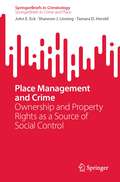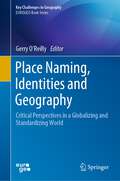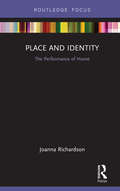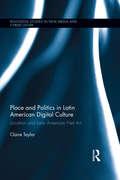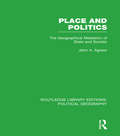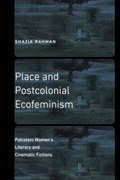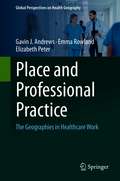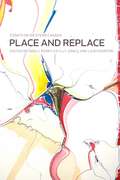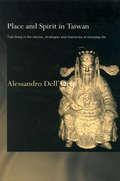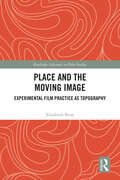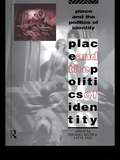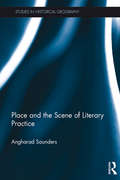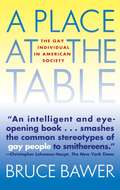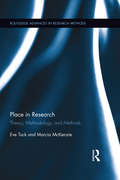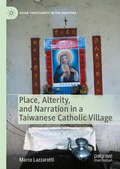- Table View
- List View
Place Management and Crime: Ownership and Property Rights as a Source of Social Control (SpringerBriefs in Criminology)
by John E. Eck Shannon J. Linning Tamara D. HeroldThis brief describes the theory and evidence of a form of social control known as place management. Created by property owners, place management is an alternative to the two other domains of social control: formally created by the state and informally created by residents. It helps explain the high concentration of crime and disorder at a relatively small proportion of addresses and facilities. This volume examines the specifics of place management and extends it in three ways: to show how high crime places may radiate crime into their surroundings; to reveal networks of places that create crime hotspot spanning blocks; to demonstrate how networks of place managers influence crime throughout neighborhoods. Finally, it shows that the policy implications of place management extend far beyond the police and should include regulatory policies.
Place Matters
by David Weisburd Anthony A. Braga Cynthia Lum Charlotte Gill Gerben Bruinsma Weisburd, David and Eck, John E. and Braga, Anthony A. and Telep, Cody W. and Cave, Breanne and Bowers, Kate and Bruinsma, Gerben and Gill, Charlotte and Groff, Elizabeth R. and Hibdon, Julie and Hinkle, Joshua C. and Johnson, Shane D. and Lawton, Brian an John E. Eck Cody W. Telep Breanne Cave Kate Bowers Elizabeth R. Groff Julie Hibdon Joshua C. Hinkle Shane D. Johnson Brian Lawton Jerry H. Ratcliffe George Rengert Travis Taniguchi Sue-Ming YangOver the last two decades, there has been increased interest in the distribution of crime and other antisocial behavior at lower levels of geography. The focus on micro geography and its contribution to the understanding and prevention of crime has been called the 'criminology of place'. It pushes scholars to examine small geographic areas within cities, often as small as addresses or street segments, for their contribution to crime. Here, the authors describe what is known about crime and place, providing the most up-to-date and comprehensive review available. Place Matters shows that the study of criminology of place should be a central focus of criminology in the twenty-first century. It creates a tremendous opportunity for advancing our understanding of crime, and for addressing it. The book brings together eighteen top scholars in criminology and place to provide comprehensive research expanding across different themes.
Place Names of Wisconsin
by Edward CallaryThe colorful history and culture of Wisconsin are reflected in its place names, from those created by Native Americans, French explorers, and diverse European settlers to more recent appellations commemorating political figures, postmasters, and landowners. Organized alphabetically for easy reference, Edward Callary's concise entries reveal the stories behind such intriguing names as Fussville, Misha Mokwa, Couderay, and Thiry Daems. Fun to read and packed with information, Place Names of Wisconsin is a must-have for anyone interested in Wisconsin and Midwest history, language, geography, and culture--or anyone who simply wonders "why did they name it that?"
Place Naming, Identities and Geography: Critical Perspectives in a Globalizing and Standardizing World (Key Challenges in Geography)
by Gerry O’ReillyThis book presents research on geographical naming on land and sea from a wide range of standpoints on: theory and concepts, case studies and education. Space and place naming or toponymy has a long tradition in the sciences and a renewed critical interest in geography and allied disciplines including the humanities. Place: location and cartographical aspects, etymology and geo-histories so salient in past studies, are now being enhanced from a range of radical perspectives, especially in a globalizing, standardizing world with Googlization and the consequent ‘normalization’ of place names, perceptions and images worldwide including those for marketing purposes. Nonetheless, there are conflicting and contesting voices. The interdisciplinary research is enhanced with authors from regional, national and international toponymy-related institutions and organizations including the UNGEGN, IGU, ICA and so forth.
Place and Identity: The Performance of Home (Routledge Focus on Housing and Philosophy)
by Joanna RichardsonThe UK is experiencing a housing crisis unlike any other. Homelessness is on the increase and more people are at the mercy of landlords due to unaffordable housing. Place and Identity: Home as Performance highlights that the meaning of home is not just found within the bricks and mortar; it is constructed from the network of place, space and identity and the negotiation of conflict between those – it is not a fixed space but a link with land, ancestry and culture. This book fuses philosophy and the study of home based on many years of extensive research. Richardson looks at how the notion of home, or perhaps the lack of it, can affect identity and in turn the British housing market. This book argues that the concept of ‘home’ and physical housing are intrinsically linked and that until government and wider society understand the importance of home in relation to housing, the crisis is only likely to get worse. This book will be essential reading for postgraduate students whose interest is in housing and social policy, as well as appealing to those working in the areas of implementing and changing policy within government and professional spaces.
Place and People: An Ecology of a New Guinean Community
by William C. ClarkeThis title is part of UC Press's Voices Revived program, which commemorates University of California Press’s mission to seek out and cultivate the brightest minds and give them voice, reach, and impact. Drawing on a backlist dating to 1893, Voices Revived makes high-quality, peer-reviewed scholarship accessible once again using print-on-demand technology. This title was originally published in 1971.
Place and Politics in Latin American Digital Culture: Location and Latin American Net Art (Routledge Studies in New Media and Cyberculture #20)
by Claire TaylorThis volume explores one of the central issues that has been debated in internet studies in recent years: locality, and the extent to which cultural production online can be embedded in a specific place. The particular focus of the book is on the practices of net artists in Latin America, and how their work interrogates some of the central place-based concerns of Latin(o) American identity through their on- and offline cultural practice. Six particular works by artists of different countries in Latin America and within Latina/o communities in the US are studied in detail, with one each from Uruguay, Chile, Argentina, Colombia, the US-Mexico border, and the US. Each chapter explores how each artist represents place in their works, and, in particular how traditional place-based affiliations, or notions of territorial identity, end up reproduced, re-affirmed, or even transformed online. At the same time, the book explores how these net.artists make use of new media technologies to express alternative viewpoints about the locations they represent, and use the internet as a space for the recuperation of cultural memory.
Place and Politics: The Geographical Mediation of State and Society (Routledge Library Editions: Political Geography #243)
by John A. AgnewThe first part of the book is concerned with developing the place perspective. Three dimensions of place are put forward: locale and sense of place describe the objective and subjective dimensions of local social arrangements within which political behaviour is realized; location refers to the impact of the ‘macro-order’, to the fact that a single place is one among many and that the social life of a place is embedded in theworkings of the state and the world economy. The second part of the book provides detailed examinations of American and Scottish politics, using the place perspective. Contrary to the view that place or locality is important only in ‘traditional societies’, this book argues that place is of continuing significance in even the most ‘advanced’ societies.
Place and Postcolonial Ecofeminism: Pakistani Women's Literary and Cinematic Fictions (Expanding Frontiers: Interdisciplinary Approaches to Studies of Women, Gender, and Sexuality)
by Shazia RahmanWhile news reports about Pakistan tend to cover Taliban attacks and bombings, and academics focus on security issues, the environment often takes a backseat in media reportage and scholarship. In particular, Pakistani women’s attachment to their environment and their environmental concerns are almost always ignored. Shazia Rahman traces the ways in which Pakistani women explore alternative, environmental modes of belonging, examines the vitality of place-based identities within Pakistani culture, and thereby contributes to evolving understandings of Pakistani women—in relation to both their environment and to various discourses of nation and patriarchy. Through an astute analysis of such works as Sabiha Sumar’s Khamosh Pani (2003), Mehreen Jabbar’s Ramchand Pakistani (2008), Sorayya Khan’s Noor (2006), Uzma Aslam Khan’s Trespassing (2003), and Kamila Shamsie’s Burnt Shadows (2009), Rahman illuminates how Pakistani women’s creative works portray how people live with one another, deal with their environment, and intuit their relationship with the spiritual. She considers how literary and cinematic documentation of place-based identities simultaneously critiques and counters stereotypes of Pakistan as a country of religious nationalism and oppressive patriarchy. Rahman’s analysis discloses fresh perspectives for thinking about the relationship between social and environmental justice.
Place and Professional Practice: The Geographies in Healthcare Work (Global Perspectives on Health Geography)
by Gavin J. Andrews Emma Rowland Elizabeth PeterThis book presents the first single comprehensive analysis of the scope of geographical realities and relevance in health care work. Conceptually, the book conveys how space, place and geographical ideas matter to clinical practice, from the historical beginnings of professional roles and responsibilities in medicine to the present day. In 8 chapters, the book covers healthcare work across a range of job types (including physician, nurse, and multiple technical and therapeutic roles in multiple specialties), and across a range of scales (focusing on global issues and trends, national and regional particularities, urban and rural issues, institutional environments and various community settings). This book is intended for students, teachers, and researchers in geography, social science and various health sciences. Chapter 1 examines how geographical ideas have been central to practitioners' thinking and practice over time. Chapter 2 reviews the scope of contemporary geographical study of health care work. Chapter 3 presents an empirical case study of the geographies in hospital-based ward work. Chapter 4 presents an empirical case study of the geographies in ambulance/rapid response work. Chapter 5 presents a case study of the geographies associated with a high profile case of criminality and neglect in practice. Chapter 6 considers concepts and the geographies in person-centred care. Chapter 7 considers concepts and the geographies in skills attainment.
Place and Replace: Essays on Western Canada
by Adele Perry Esyllt W. Jones Leah MortonPlace and Replace is a collection of recent interdisciplinary research into Western Canada that calls attention to the multiple political, social, and cultural labours performed by the concept of “place.” The book continues a long-standing tradition of situating questions of place at the centre of analyses of Western Canada’s cultures, pasts, and politics, while making clear that place is never stable, universal, or static. The essays here confirm the interests and priorities of Western Canadian scholarship that have emerged over the past forty years and remind us of the importance of Indigenous peoples, dispossession, and colonialism; of migration, race and ethnicity; of gender and women’s experiences; of the impact of the natural and built environment; and the impact of politics and the state.
Place and Spirit in Taiwan: Tudi Gong in the Stories, Strategies and Memories of Everyday Life
by Alessandro Dell'OrtoBased on field-work in Taiwan, this book examines the ancient, indigenous religious cult of Tudi Gong both as a religio-social phenomenon and as an appropriate medium for exploring and analysing the social changes that have been occurring in contemporary Taiwan, and the people's strategic adaptations to these changes. In this comprehensive ethnography of Tudi Gong, Dell'Orto engages in a theoretical discussion of the practices, processes and strategies of ethnography and ethnographic writing, and contributes to the construction of an anthropology of place by analysing a number of key concepts related to the notion of place and space. The study combines the use of personal ethnography with raconteurs' own accounts as a way of tracing senses of place and memories of the past. This is a pioneering foundation text for an anthropology of non domestic place and space and brings the most important recent work of social geographers into the field of anthropology.
Place and the Moving Image: Experimental Film Practice as Topography (Routledge Advances in Film Studies)
by Elisabeth BrunPlace and the Moving Image offers a rethinking of how experimental film, and especially essay film practices, engage with spatial knowledge and environmental awareness. At its heart is the concept of Moving Image Topography – a critical and artistic model for thinking with the moving image about the relation between technological forms and place structures, and how these shape our experience of environments, whether natural, built and lived.Responding to urgent questions in eco-media and artistic research, Elisabeth Brun argues that place is not merely a setting or backdrop, but a critical generative force in experimental film – a vital lens for understanding the eco-critical and epistemological potential of moving image arts and their modes of thinking. Through a rigorous and interdisciplinary approach that combines theory, close readings of essayist and materialist film practices, and artistic research in her sub-Arctic home village, Brun explores how the moving image can render visible the often invisible dynamics between perceptual experience, spatial environments and technological mediation. Rather than treating theory and practice as separate domains, this book shows how both emerge from the same topographical foundation. At stake is not only how to understand film, but how we understand our own grounding – the inseparability of Earth’s textures and our forms of experience, through which perspective itself can be (re)gained. It will engage scholars, artists and practitioners interested in place, environmental aesthetics, indigenous perspectives and critical film practice – across fields such as film and media studies, visual art, design, architecture and philosophy.The experimental film 3xShapes of Home (2020) is central to this study and is included as a Routledge online Support Material to this book.
Place and the Politics of Identity
by Steve Pile Michael KeithIn the last two decades, new political subjects have been created through the actions of the new social movements; often by asserting the unfixed and `overdetermined' character of identity. Further, in attempting to avoid essentialism, people have frequently looked to their territorial roots to establish their constituency. A cultural politics of resistance, as exemplified by Black politics, feminism, and gay liberation, has developed struggles to turn sites of oppression and discrimintion into spaces of resistance. This book collects together perspectives which challenge received notions of geography; which are in danger of becoming anachronisms, without a language to articulate the new space of resistance, the new politics of identity.
Place and the Scene of Literary Practice (Studies in Historical Geography)
by Angharad SaundersThe act of writing is intimately bound up with the flow and eddy of a writer’s being-within-the-world; the everyday practices, encounters and networks of social life. Exploring the geographies of literary practice in the period 1840-1910, this book takes as its focus the work, or craft, of authorship, exploring novels not as objects awaiting interpretation, but as spatial processes of making meaning. As such, it is interested in literary creation not only as something that takes place - the situated nature of putting pen to paper - but simultaneously as a process that escapes such placing. Arguing that writing is a process of longue durée, the book explores the influence of family and friends in the creative process, it draws attention to the role that travel and movement play in writing and it explores the wider commitments of authorial life, not as indicators of intertextuality, but as part of the creative process. In taking this seventy year period as its focus, this book moves beyond the traditional periodisations that have characterised literary studies, such as the Victorian or Edwardian novel, the nineteenth-century or early twentieth-century novel or Romanticism, social realism and modernism. It argues that the literary environment was not one of watershed moments; there were continuities between writers separated by several decades or writing in different centuries. At the same time, it draws attention to a seventy year period in which the value of literary work and culture were being contested and transformed. Place and the Scene of Literary Practice will be key reading for those working in Human Geography, particularly Cultural and Historical Geography, Literary Studies and Literary History.
Place at the Table: The Gay Individual in American Society
by Bruce BawerBruce Bawer exposes the heated controversy over gay rights and presents a passionate plea for the recognition of common values, "a place at the table" for everyone. Homosexuality is being talked about more today than at any other time in human history; the issue of gay rights has reached a moment of truth. Now comes a gay writer's powerful meditation on the nature of homosexuality and the need to resist confining stereotypes.
Place in Research: Theory, Methodology, and Methods (Routledge Advances in Research Methods #9)
by Eve Tuck Marcia McKenzieBridging environmental and Indigenous studies and drawing on critical geography, spatial theory, new materialist theory, and decolonizing theory, this dynamic volume examines the sometimes overlooked significance of place in social science research. There are often important divergences and even competing logics at work in these areas of research, some which may indeed be incommensurable. This volume explores how researchers around the globe are coming to terms - both theoretically and practically - with place in the context of settler colonialism, globalization, and environmental degradation. Tuck and McKenzie outline a trajectory of critical place inquiry that not only furthers empirical knowledge, but ethically imagines new possibilities for collaboration and action. Critical place inquiry can involve a range of research methodologies; this volume argues that what matters is how the chosen methodology engages conceptually with place in order to mobilize methods that enable data collection and analyses that address place explicitly and politically. Unlike other approaches that attempt to superficially tag on Indigenous concerns, decolonizing conceptualizations of land and place and Indigenous methods are central, not peripheral, to practices of critical place inquiry.
Place, Alterity, and Narration in a Taiwanese Catholic Village (Asian Christianity in the Diaspora)
by Marco LazzarottiThis book introduces a simple idea: when we tell a story, we tell a story and at the same time create the world where this story takes place. Narration creates environments, spaces and, in a certain sense, gives symbolic meanings and values to the identities by which people interact in their daily experiences. Set in the multicultural and multireligious Taiwanese environment, this book describes the interactions, and above all the narrations, linked to a Catholic village located in the Taiwanese countryside. Catholicism in Taiwan is a minor religion (around 2% of the population), and considered a foreign and heterodox religion, something different and "other" from the Taiwanese mainstream religious environment. It is this sense of alterity that creates the stories about this place and, as a consequence, creates this place and its special identity.
Place, Catholicism and Violence: The Construction of Place in Caracas’ Barrios
by Gabriela Quintana VigiolaThis book explores the interwoven nature of place, Catholicism and violence in Caracas’ barrios. Using interdisciplinary perspectives to investigate themes of urban space, meaning as a psychosocial construct, criminal violence, and religiosity as culture, this book uncovers the underlying complexities of turning spaces into places through the built form, activities in the urban space and the meanings associated with it. Fundamental elements in the construction of place are used to understand the ways in which barrio residents conceive and construct the physicality of the private, public and religious spaces; how residents use the physical spaces of the barrios; and the psychosocial meanings residents associate with the spaces and activities. Using rich qualitative data and a case study design, the book relies on audio-visual data and interviews with organisers, residents and key participants in Petare, the largest barrio conglomeration in Caracas and Venezuela. Qualitative thematic analysis of participants’ experiences of Catholicism, violence and, ultimately, the construction of place exposes a unique argument: that meaningful urban spaces are embedded with emotions, memories, relationships, experiences and meanings, which turn them into places.
Place, Diversity and Solidarity (Routledge Studies in Human Geography)
by Stijn Oosterlynck Nick Schuermans Maarten LoopmansIn many countries, particularly in the Global North, established forms of solidarity within communities are said to be challenged by the increasing ethnic and cultural diversity of the population. Against the backdrop of renewed geopolitical tensions – which inflate and exploit ethno-cultural, rather than political-economic cleavages – concerns are raised that ethnic and cultural diversity challenge both the formal mechanisms of redistribution and informal acts of charity, reciprocity and support which underpin common notions of community. This book focuses on the innovative forms of solidarity that develop around the joint appropriation and the envisaged common future of specific places. Drawing on examples from schools, streets, community centres, workplaces, churches, housing projects and sporting projects, it provides an alternative research agenda from the 'loss of community' narrative. It reflects on the different spatiotemporal frames in which solidarities are nurtured, the connections forged between solidarity and citizenship, and the role of interventions by professionals to nurture solidarity in diversity. This timely and original work will be essential reading for those working in human geography, sociology, ethnic studies, social work, urban studies, political studies and cultural studies.
Place, Health, and Diversity: Learning from the Canadian Experience (Geographies of Health Series)
by Melissa D. Giesbrecht Valorie A. CrooksAlthough health equity and diversity-focussed research has begun to gain momentum, there is still a paucity of research from health geographers that explicitly explores how geographic factors, such as place, space, scale, community, and location, inform multiple axes of difference. Such axes can include residential location, age, sex, gender, race/ethnicity, culture, religion, socio-economic status, marital status, sexual orientation, education level, and immigration status. Specifically focussing on Canada’s rapidly changing society, which is becoming increasingly pluralized and diverse, this book examines the place-health-diversity intersection in this national context. Health geographers are well positioned to offer a valuable contribution to diversity-focussed research because place is inextricably linked to differential experiences of health. For example, access to health care and health promoting services and resources is largely influenced by where one is physically and socially situated within the web of diversity. Furthermore, applying geographic concepts like place, in both the physical and social sense, allows researchers to explore multiple axes of difference simultaneously. Such geographic perspectives, as presented in this book, offer new insights into what makes diverse people, in diverse places, with access to diverse resources (un)healthy in different ways in Canada and beyond.
Place, Identity, and National Imagination in Post-war Taiwan (Routledge Research on Taiwan Series)
by Bi-yu ChangIn the struggles for political and cultural hegemony that Taiwan has witnessed since the 1980s, the focal point in contesting narratives and the key battlefield in the political debates are primarily spatial and place-based. The major fault line appears to be a split between an imposed identity emphasizing cultural origin (China) and an emphasis on the recovery of place identity of ‘the local’ (Taiwan). Place, Identity and National Imagination in Postwar Taiwan explores the ever-present issue of identity in Taiwan from a spatial perspective, and focuses on the importance of, and the relationship between, state spatiality and identity formation. Taking postwar Taiwan as a case study, the book examines the ways in which the Kuomintang regime naturalized its political control, territorialized the island and created a nationalist geography. In so doing, it examines how, why and to what extent power is exercised through the place-making process and considers the relationship between official versions of ‘ROC geography’ and the islanders’ shifting perceptions of the ‘nation’. In turn, by addressing the relationship between the state and the imagined community, Bi-yu Chang establishes a dialogue between place and cultural identity to analyse the constant changing and shaping of Chinese and Taiwanese identity. With a diverse selection of case studies including cartographical development, geography education, territorial declaration and urban planning, this interdisciplinary book will have a broad appeal across Taiwan studies, geography, cultural studies, history and politics.
Place, Memory, and Healing: An Archaeology of Anatolian Rock Monuments
by Ömür HarmanşahPlace, Memory, and Healing: An Archaeology of Anatolian Rock Monuments investigates the complex and deep histories of places, how they served as sites of memory and belonging for local communities over the centuries, and how they were appropriated and monumentalized in the hands of the political elites. Focusing on Anatolian rock monuments carved into the living rock at watery landscapes during the Late Bronze and Early Iron Ages, this book develops an archaeology of place as a theory of cultural landscapes and as an engaged methodology of fieldwork in order to excavate the genealogies of places. Advocating that archaeology can contribute substantively to the study of places in many fields of research and engagement within the humanities and the social sciences, this book seeks to move beyond the oft-conceived notion of places as fixed and unchanging, and argues that places are always unfinished, emergent, and hybrid. Rock cut monuments of Anatolian antiquity are discussed in the historical and micro-regional context of their making at the time of the Hittite Empire and its aftermath, while the book also investigates how such rock-cut places, springs, and caves are associated with new forms of storytelling, holy figures, miracles, and healing in their post-antique life. Anybody wishing to understand places of cultural significance both archaeologically as well as through current theoretical lenses such as heritage studies, ethnography of landscapes, social memory, embodied and sensory experience of the world, post-colonialism, political ecology, cultural geography, sustainability, and globalization will find the case studies and research within this book a doorway to exploring places in new and rewarding ways.
Place, Migration and Development in the Third World: An Alternative Perspective
by Lawrence A. BrownProviding a fresh examination of the nature of Third World development, the author focuses on the characteristics of particular places and regions and their influences on behaviour. This is an important study of the relationship between population movements and regional and national changes.
Place, Not Race
by Sheryll CashinFrom a nationally recognized expert, a fresh and original argument for bettering affirmative action Race-based affirmative action had been declining as a factor in university admissions even before the recent spate of related cases arrived at the Supreme Court. Since Ward Connerly kickstarted a state-by-state political mobilization against affirmative action in the mid-1990s, the percentage of four-year public colleges that consider racial or ethnic status in admissions has fallen from 60 percent to 35 percent. Only 45 percent of private colleges still explicitly consider race, with elite schools more likely to do so, although they too have retreated. For law professor and civil rights activist Sheryll Cashin, this isn't entirely bad news, because as she argues, affirmative action as currently practiced does little to help disadvantaged people. The truly disadvantaged--black and brown children trapped in high-poverty environs--are not getting the quality schooling they need in part because backlash and wedge politics undermine any possibility for common-sense public policies. Using place instead of race in diversity programming, she writes, will better amend the structural disadvantages endured by many children of color, while enhancing the possibility that we might one day move past the racial resentment that affirmative action engenders. In Place, Not Race, Cashin reimagines affirmative action and champions place-based policies, arguing that college applicants who have thrived despite exposure to neighborhood or school poverty are deserving of special consideration. Those blessed to have come of age in poverty-free havens are not. Sixty years since the historic decision, we're undoubtedly far from meeting the promise of Brown v. Board of Education, but Cashin offers a new framework for true inclusion for the millions of children who live separate and unequal lives. Her proposals include making standardized tests optional, replacing merit-based financial aid with need-based financial aid, and recruiting high-achieving students from overlooked places, among other steps that encourage cross-racial alliances and social mobility. A call for action toward the long overdue promise of equality, Place, Not Race persuasively shows how the social costs of racial preferences actually outweigh any of the marginal benefits when effective race-neutral alternatives are available.From the Hardcover edition.
